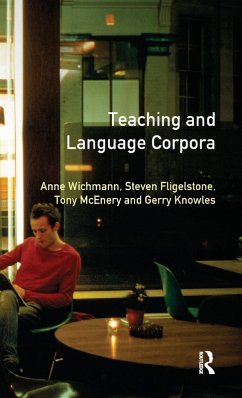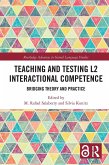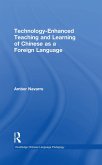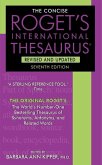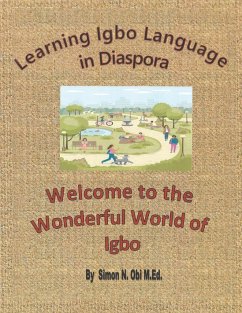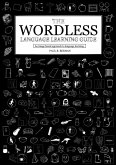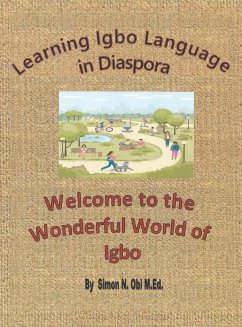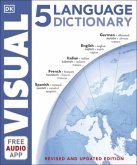- Gebundenes Buch
- Merkliste
- Auf die Merkliste
- Bewerten Bewerten
- Teilen
- Produkt teilen
- Produkterinnerung
- Produkterinnerung
First Published in 1998. Routledge is an imprint of Taylor & Francis, an informa company.
Andere Kunden interessierten sich auch für
![Teaching and Testing L2 Interactional Competence Teaching and Testing L2 Interactional Competence]() Teaching and Testing L2 Interactional Competence67,99 €
Teaching and Testing L2 Interactional Competence67,99 €![Technology-Enhanced Teaching and Learning of Chinese as a Foreign Language Technology-Enhanced Teaching and Learning of Chinese as a Foreign Language]() Amber NavarreTechnology-Enhanced Teaching and Learning of Chinese as a Foreign Language206,99 €
Amber NavarreTechnology-Enhanced Teaching and Learning of Chinese as a Foreign Language206,99 €![The Concise Roget's International Thesaurus The Concise Roget's International Thesaurus]() Barbara Ann KipferThe Concise Roget's International Thesaurus8,99 €
Barbara Ann KipferThe Concise Roget's International Thesaurus8,99 €![Learning Igbo Language in Diaspora Learning Igbo Language in Diaspora]() Obi M. Ed. Simon N.Learning Igbo Language in Diaspora30,99 €
Obi M. Ed. Simon N.Learning Igbo Language in Diaspora30,99 €![The Wordless Language Learning Guide The Wordless Language Learning Guide]() Paul R. BeemanThe Wordless Language Learning Guide23,99 €
Paul R. BeemanThe Wordless Language Learning Guide23,99 €![Learning Igbo Language in Diaspora Learning Igbo Language in Diaspora]() Obi M. Ed. Simon N.Learning Igbo Language in Diaspora39,99 €
Obi M. Ed. Simon N.Learning Igbo Language in Diaspora39,99 €![5 Language Visual Dictionary 5 Language Visual Dictionary]() DK5 Language Visual Dictionary15,99 €
DK5 Language Visual Dictionary15,99 €-
-
-
First Published in 1998. Routledge is an imprint of Taylor & Francis, an informa company.
Hinweis: Dieser Artikel kann nur an eine deutsche Lieferadresse ausgeliefert werden.
Hinweis: Dieser Artikel kann nur an eine deutsche Lieferadresse ausgeliefert werden.
Produktdetails
- Produktdetails
- Verlag: Routledge
- Seitenzahl: 362
- Erscheinungstermin: 23. Februar 2017
- Englisch
- Abmessung: 222mm x 145mm x 23mm
- Gewicht: 587g
- ISBN-13: 9781138167346
- ISBN-10: 1138167347
- Artikelnr.: 71711779
- Herstellerkennzeichnung
- Libri GmbH
- Europaallee 1
- 36244 Bad Hersfeld
- gpsr@libri.de
- Verlag: Routledge
- Seitenzahl: 362
- Erscheinungstermin: 23. Februar 2017
- Englisch
- Abmessung: 222mm x 145mm x 23mm
- Gewicht: 587g
- ISBN-13: 9781138167346
- ISBN-10: 1138167347
- Artikelnr.: 71711779
- Herstellerkennzeichnung
- Libri GmbH
- Europaallee 1
- 36244 Bad Hersfeld
- gpsr@libri.de
Anne Wichmann Steven Fligelstone
Preface
Foreward
Acknowledgements
List of Contributors
General Introduction
1. Teaching and Language Corpora: a Convergence, G.Leech
Section A Why use corpora?
2. Corpus Evidence in Language Description, J.M. Sinclair
3. Corpora and the Design of Teaching Materials, D. Mindt
4. Enriching the Learning Environment: Corpora in ELT, G. Aston
Section B Teaching Languages
5. All the Languge That's Fit to Print: Using British and American
Newspaper CD-ROMs as Corpora,
D. Minugh
6. Exporing Texts through the Concordancer: Guiding the Learner, L. Gavioli
7. Contexts: the Backgroud, Development and Trialling of a
Concordance-based CALL Program, T. Johns
8. The Automatic Generation of CALL Exercises from General Corpora, E.
Wilson
9. Exploiting a Corpus of Written German for Advanced Language Learning,
W. Dodd
10. Creating and Using a Corpus of Spoken German, R. Jones
11. The Role of Coropra in Studying and Promoting Welsh,K. Ahmad & A.
Davies
Section C Teaching Linguistics
12. Micro- and Macro-linguistics for Natural Language Processing,P. Peters
13. Using a Corpus to Evaluate Theories of Child Language Acquisition, B.
Ketteman
14. Using Corpora for the Diachronic Study of English, G. Knowles
15. The Use of an Annotated Speech Corpus in the Teaching of Prosody, A.
Wichmann
16. Corpus and Concordance: Finding out about Style, H. Jackson
17. The Role of Corpora in Critical Literary Appreciation, B. Louw
18. Teaching Corpus Linguistics to Teachers of English,A. Renouf
Section D Practical Perspectives
19. First Catch your Corpus: Building an Undergraduate Corpus of French
from Freely Available Textual Resources,G. Inkster
20. Creating and Processing Corpora in Greek and Cyrillic Alphabets on the
Personal Computer, P. King
21. Developing a Computing Infrastructure for Corpus-based Teaching,G.
Hughes
Appendices
References
Index
Foreward
Acknowledgements
List of Contributors
General Introduction
1. Teaching and Language Corpora: a Convergence, G.Leech
Section A Why use corpora?
2. Corpus Evidence in Language Description, J.M. Sinclair
3. Corpora and the Design of Teaching Materials, D. Mindt
4. Enriching the Learning Environment: Corpora in ELT, G. Aston
Section B Teaching Languages
5. All the Languge That's Fit to Print: Using British and American
Newspaper CD-ROMs as Corpora,
D. Minugh
6. Exporing Texts through the Concordancer: Guiding the Learner, L. Gavioli
7. Contexts: the Backgroud, Development and Trialling of a
Concordance-based CALL Program, T. Johns
8. The Automatic Generation of CALL Exercises from General Corpora, E.
Wilson
9. Exploiting a Corpus of Written German for Advanced Language Learning,
W. Dodd
10. Creating and Using a Corpus of Spoken German, R. Jones
11. The Role of Coropra in Studying and Promoting Welsh,K. Ahmad & A.
Davies
Section C Teaching Linguistics
12. Micro- and Macro-linguistics for Natural Language Processing,P. Peters
13. Using a Corpus to Evaluate Theories of Child Language Acquisition, B.
Ketteman
14. Using Corpora for the Diachronic Study of English, G. Knowles
15. The Use of an Annotated Speech Corpus in the Teaching of Prosody, A.
Wichmann
16. Corpus and Concordance: Finding out about Style, H. Jackson
17. The Role of Corpora in Critical Literary Appreciation, B. Louw
18. Teaching Corpus Linguistics to Teachers of English,A. Renouf
Section D Practical Perspectives
19. First Catch your Corpus: Building an Undergraduate Corpus of French
from Freely Available Textual Resources,G. Inkster
20. Creating and Processing Corpora in Greek and Cyrillic Alphabets on the
Personal Computer, P. King
21. Developing a Computing Infrastructure for Corpus-based Teaching,G.
Hughes
Appendices
References
Index
Preface
Foreward
Acknowledgements
List of Contributors
General Introduction
1. Teaching and Language Corpora: a Convergence, G.Leech
Section A Why use corpora?
2. Corpus Evidence in Language Description, J.M. Sinclair
3. Corpora and the Design of Teaching Materials, D. Mindt
4. Enriching the Learning Environment: Corpora in ELT, G. Aston
Section B Teaching Languages
5. All the Languge That's Fit to Print: Using British and American
Newspaper CD-ROMs as Corpora,
D. Minugh
6. Exporing Texts through the Concordancer: Guiding the Learner, L. Gavioli
7. Contexts: the Backgroud, Development and Trialling of a
Concordance-based CALL Program, T. Johns
8. The Automatic Generation of CALL Exercises from General Corpora, E.
Wilson
9. Exploiting a Corpus of Written German for Advanced Language Learning,
W. Dodd
10. Creating and Using a Corpus of Spoken German, R. Jones
11. The Role of Coropra in Studying and Promoting Welsh,K. Ahmad & A.
Davies
Section C Teaching Linguistics
12. Micro- and Macro-linguistics for Natural Language Processing,P. Peters
13. Using a Corpus to Evaluate Theories of Child Language Acquisition, B.
Ketteman
14. Using Corpora for the Diachronic Study of English, G. Knowles
15. The Use of an Annotated Speech Corpus in the Teaching of Prosody, A.
Wichmann
16. Corpus and Concordance: Finding out about Style, H. Jackson
17. The Role of Corpora in Critical Literary Appreciation, B. Louw
18. Teaching Corpus Linguistics to Teachers of English,A. Renouf
Section D Practical Perspectives
19. First Catch your Corpus: Building an Undergraduate Corpus of French
from Freely Available Textual Resources,G. Inkster
20. Creating and Processing Corpora in Greek and Cyrillic Alphabets on the
Personal Computer, P. King
21. Developing a Computing Infrastructure for Corpus-based Teaching,G.
Hughes
Appendices
References
Index
Foreward
Acknowledgements
List of Contributors
General Introduction
1. Teaching and Language Corpora: a Convergence, G.Leech
Section A Why use corpora?
2. Corpus Evidence in Language Description, J.M. Sinclair
3. Corpora and the Design of Teaching Materials, D. Mindt
4. Enriching the Learning Environment: Corpora in ELT, G. Aston
Section B Teaching Languages
5. All the Languge That's Fit to Print: Using British and American
Newspaper CD-ROMs as Corpora,
D. Minugh
6. Exporing Texts through the Concordancer: Guiding the Learner, L. Gavioli
7. Contexts: the Backgroud, Development and Trialling of a
Concordance-based CALL Program, T. Johns
8. The Automatic Generation of CALL Exercises from General Corpora, E.
Wilson
9. Exploiting a Corpus of Written German for Advanced Language Learning,
W. Dodd
10. Creating and Using a Corpus of Spoken German, R. Jones
11. The Role of Coropra in Studying and Promoting Welsh,K. Ahmad & A.
Davies
Section C Teaching Linguistics
12. Micro- and Macro-linguistics for Natural Language Processing,P. Peters
13. Using a Corpus to Evaluate Theories of Child Language Acquisition, B.
Ketteman
14. Using Corpora for the Diachronic Study of English, G. Knowles
15. The Use of an Annotated Speech Corpus in the Teaching of Prosody, A.
Wichmann
16. Corpus and Concordance: Finding out about Style, H. Jackson
17. The Role of Corpora in Critical Literary Appreciation, B. Louw
18. Teaching Corpus Linguistics to Teachers of English,A. Renouf
Section D Practical Perspectives
19. First Catch your Corpus: Building an Undergraduate Corpus of French
from Freely Available Textual Resources,G. Inkster
20. Creating and Processing Corpora in Greek and Cyrillic Alphabets on the
Personal Computer, P. King
21. Developing a Computing Infrastructure for Corpus-based Teaching,G.
Hughes
Appendices
References
Index

